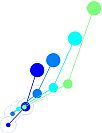Human choices in uncertainty have been observed in some specific decision situations to derive from additively (independently) combining choice outcome probabilities and values rather than from integrating these expected outcome attributes in subjective expected utilities as proposed in prospect theory. It remains unknown whether the additive selection policy generalizes to various decision situations outlined in prospect theory (low versus high environment volatility, gains versus losses domain, small versus large outcome value scales) and how weighing probabilities relative to values is determined. In the present study we investigated these two issues in a series of behavioral experiments in humans. We found evidence ruling out prospect theory as an account of human choices in all tested situations. Instead, human choices derived from the additive selection policy. Moreover, we found that human choices accommodated the environment changes by solely varying the weight of probabilities relative to values. Specifically, the weight reduced with the increase of environment volatility regardless of the outcome domain. And the weight increased with the increase of the outcome value scale in the gain domain only. These weight variations account for the risk-aversion and loss-aversion effects described in prospect theory. Our results suggest that decision-making derives from flexibly combining multiple independent within-attribute option comparisons depending upon the decision situations. The latter decision model easily extends to include additional decision attributes accounting for exploration and exploitation behavior, like prospective information gains and reinforcement learning values.

 PDF version
PDF version
